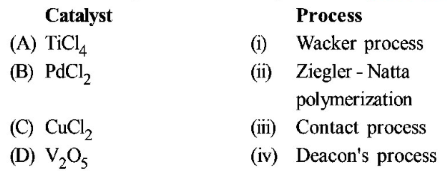261. In context with the transition elements, which of the following statements is incorrect?
A
In addition to the normal oxidation states, the zero oxidation state is also shown by these elements in complexes.
B
In the highest oxidation states, the transition metals show basic character and form cationic complexes.
C
In the highest oxidation states of the first five transition elements $$\left( {Sc\,\,{\text{to}}\,\,Mn} \right),$$ all the $$4s$$ and $$3d$$ electrons are used for bonding.
D
Once the $${d^5}$$ configuration is exceeded, the tendency to involve all the $$3d$$ - electrons in bonding decreases.
Answer :
In the highest oxidation states, the transition metals show basic character and form cationic complexes.
262. The correct order of ionic radii of $${Y^{3 + }},L{a^{3 + }},E{u^{3 + }}$$ and $$L{u^{3 + }}$$ is $$\left( {{\text{At}}{\text{. no}}{\text{.}}} \right.\,Y = 39,La = 57,$$ $$\left. {Eu = 63,Lu = 71} \right)$$
A
$$L{u^{3 + }} < E{u^{3 + }} < L{a^{3 + }} < {Y^{3 + }}$$
B
$$L{a^{3 + }} < E{u^{3 + }} < L{u^{3 + }} < {Y^{3 + }}$$
C
$${Y^{3 + }} < L{a^{3 + }} < E{u^{3 + }} < L{u^{3 + }}$$
D
$${Y^{3 + }} < L{u^{3 + }} < E{u^{3 + }} < L{a^{3 + }}$$
Answer :
$${Y^{3 + }} < L{u^{3 + }} < E{u^{3 + }} < L{a^{3 + }}$$
263. Which of the following arrangements does not represent the correct order of the property stated against it ?
A
$${V^{2 + }} < C{r^{2 + }} < M{n^{2 + }} < F{e^{2 + }}:$$ paramagnetic behaviour
B
$$N{i^{2 + }} < C{o^{2 + }} < F{e^{2 + }} < M{n^{2 + }}:$$ ionic size
C
$$C{o^{3 + }} < F{e^{3 + }} < C{r^{3 + }} < S{c^{3 + }}:$$ stability in aqueous solution
D
$$Sc < Ti < Cr < Mn:$$ number of oxidation states
Answer :
$${V^{2 + }} < C{r^{2 + }} < M{n^{2 + }} < F{e^{2 + }}:$$ paramagnetic behaviour
264. Which one of the following ionic species will impart colour to an aqueous solution?
A
$$T{i^{4 + }}$$
B
$$C{u^ + }$$
C
$$Z{n^{2 + }}$$
D
$$C{r^{3 + }}$$
Answer :
$$C{r^{3 + }}$$
265.
Match the catalysts to the correct processes :

A
A - ii, B - iii, C - iv, D - i
B
A - iii, B - i, C - ii, D - iv
C
A - iii, B - ii, C - iv, D - i
D
A - ii, B - i, C - iv, D - iii
Answer :
A - ii, B - i, C - iv, D - iii
266. Name the gas that can readily decolourise acidified $$KMn{O_4}$$ solution.
A
$$C{O_2}$$
B
$$S{O_2}$$
C
$$N{O_2}$$
D
$${P_2}{O_5}$$
Answer :
$$S{O_2}$$
267.
In an alkaline condition $$KMn{O_4}$$ reacts as follows :
$$2KMn{O_4} + 2KOH \to 2{K_2}Mn{O_4} + {H_2}O + O$$
Its equivalent weight is
A
31.6
B
52.7
C
49
D
158
Answer :
158
268. In which of the following compounds manganese has oxidation number equal to that of iodine in $$KI{O_4}?$$
A
Potassium manganate
B
Potassium permanganate
C
Manganous chloride
D
Manganese chloride
Answer :
Potassium permanganate
269.
Most of the transition metals exhibit
(i) paramagnetic behaviour
(ii) diamagnetic behaviour
(iii) variable oxidation states
(iv) coloured complexes
A
(ii), (iii) and (iv)
B
(i), (iii) and (iv)
C
(i), (ii) and (iii)
D
(i), (ii) and (iv)
Answer :
(i), (iii) and (iv)
270. Which of the following transition metal ions has highest magnetic moment?
A
$$C{u^{2 + }}$$
B
$$N{i^{2 + }}$$
C
$$C{o^{2 + }}$$
D
$$F{e^{2 + }}$$
Answer :
$$F{e^{2 + }}$$